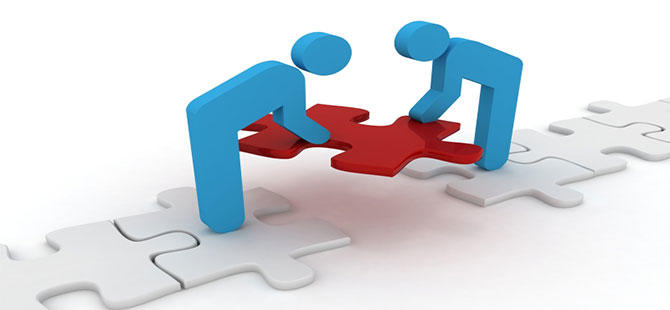Manufacturing Innovation Blog
Powered by the Manufacturing Extension Partnership

I like sit-coms. There’s nothing better than sitting back and watching your favorite characters get into (and then out of) some crazy hijinks and shenanigans to make you feel better about your day. It’s simple. And, I like that problems can be solved in less than 30 minutes. That’s efficient. I’ve been thinking about my favorite sitcoms lately and noticed a pattern: all of the best sitcoms rely on partnerships. From 70’s stalwarts like Sanford and Son and All in the Family to 80’s and 90’s staples like The Cosby Show and Friends all the way to new hits like Modern Family and The Big Bang Theory, all of the best sitcoms are based on partnerships.
Archie Bunker may have been the titular star of All in the Family… but he was only so hilarious because he was partnered with quirky wife, Edith, and “meathead” son-in-law, Michael. Can you imagine watching a half hour of just Archie? Fred Sanford was hilarious as a sarcastic junkman whose frequent get-rich-quick ideas routinely backfired, but his son Lamont was the necessarily foil as his dad’s “straight man.” People debate which is the funniest character in shows like Friends and Modern Family, but to me it’s clear that these shows achieve success because of the group dynamic highlighted in their titles. Friends doesn’t work without the friends, and Modern Family, well, requires the family—all three families that make up the whole clan. I can’t imagine Cam without Mitch, and I’m not sure Phil (the character or a real-life equivalent) would survive without Claire.
These relationships were created for a reason – their formation is to the benefit of the audience, to the story, to the characters. It’s the interactions that create the show, that make it more than a one-man (or woman) comedy routine. This is a great microcosm for partnerships. With partnerships, you bring together multiple parties, take the best aspects from each one, and work together to form a result that no one could have achieved on their own. It’s not just about any partnerships; it’s about the right partnerships. Archie Bunker sitting in his chair by himself wouldn’t have been as funny… and Archie Bunker hanging out with Ethel Mertz wouldn’t have been funny at all. Even in my head that combination just screams, “Awkward!” and refuses to mesh. Forming partnerships isn’t about haphazardly putting together random combinations – it’s about synergistic pairings in which the whole is greater than the sum of its parts. If we want to analyze Big Bang Theory, can anyone imagine Sheldon without Amy, Penny and the guys? The characters are a support system.
What does this have to do with MEP? Everything. The MEP system is built on the synergy of partnerships. MEP works with partners at the federal, state and local level to develop programs and services that help manufacturers become more innovative. Partnerships are critical because manufacturing is one of the most diverse industries in existence! Manufacturing is apparel, chemicals and fabricated metals. Manufacturing is electronics, glass, medical devices, textiles and transportation equipment. It is rural and urban, large and small companies. That’s why so many different types of partnerships are formed to drive the competitiveness of U.S. manufacturers. The MEP system spans 1,200 people, 400 offices and 60 Centers and formulates partnerships with countless resources in the following arenas:
- Federal agencies and government departments
- State agencies
- Federal and state legislators
- Universities, community colleges and technical schools
- Trade associations
- Professional societies
- Private consultants
- Industry leaders and think tanks
- Manufacturing companies of all sizes and industries
Partnerships empower the MEP network to have the most cutting-edge information and technology available. While we value all of our relationships and couldn’t possibly list them all, here are a few examples of partnerships in action:
Expanding into global markets is a critical way for manufacturers to increase sales. In fact, 95 percent of the world’s customers live outside the U.S. ExporTech™ is a program designed to help manufacturers enter or expand into global markets. It includes workshops headed by national experts and provides manufacturers with tools to develop and implement a strategic exporting plan. The program wouldn’t exist without MEP’s collaboration with U.S. Commercial Services, FedEx, U.S. Export Assistance Centers, District Export Councils, State Trade Economic and Development groups, the Export-Import Bank and the Small Business Administration.
E3 – Economy, Energy and Environment
E3- Economy, Energy and Environment enables manufacturers and the communities that they serve to advance with a focus on sustainability that makes business sense. The program helps manufacturers adopt green principles to increase productivity, foster workforce efficiency and reduce environmental impacts. This creates green jobs for local economies. The program is the result of a coordinated effort between local and federal entities including the Department of Commerce, Department of Energy, Department of Labor, Environmental Protection Agency, Small Business Administration and Department of Agriculture.
The first Friday of October marks National Manufacturing Day. The celebration was designed to expand the knowledge about and improve the public’s perception of manufacturing careers and manufacturing’s value to the U.S. economy. During the day, students, parents, educators and media members, among others, are encouraged to visit local manufacturers to learn more about their processes and the career opportunities in the manufacturing field. National Manufacturing Day is a great example of multiple partnerships and collaborations:
- The MEP network worked with public and private entities to organize more than 834 events nationwide
- Manufacturing Day was supported by co-producers including the Fabricators & Manufacturers Association, National Association of Manufacturers, Manufacturing Institute, the Science Channel and Industrial Strength Marketing; thousands of media publications covered the celebration
- A partnership with Discovery Communication’s Science Channel and “How It’s Made” led to 80 million viewers learning about Manufacturing Day on television
- 15 governors issued proclamations recognizing Manufacturing Day and 9 floor speeches were delivered by congress
These are just some of the incredible partnerships that have helped manufacturers become more globally competitive and we look forward to the many new partnerships to come. No one person or no one organization can know it all, so we have to depend on others and rely upon their expertise.
About the author
Related Posts
Comments
- Reply


